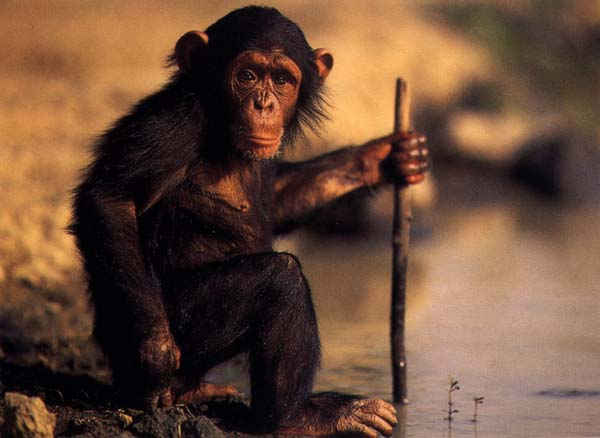 Introduction to Archaeology
and Palaeoanthropology:
Introduction to Archaeology
and Palaeoanthropology:
 Introduction to Archaeology
and Palaeoanthropology:
Introduction to Archaeology
and Palaeoanthropology:
Humanity's Journeys
Dr. Kathryn Denning
Anth 2140, Sept 2005 - Apr 2006
(Young Chimpanzee)
1 Nov 2005... Welcome!
Plan for the day
1 Course business/ announcements...
2 Continuing... our primate relatives - biology and behaviour - and early hominids
Schedule
For today/tomorrow, KIT: Macroevolution and the Early Primates, Something New and Different, and Cat in the Human Cradle. FAGAN Ch 8 Human origins.
Tomorrow in tutorial: Video: The Story of Lucy (about palaeoanthropology and Australopithecus afarensis)
Slowing down a bit: See revised reading schedule. Basically, next week is catch up / review and then we'll resume. i.e. the schedule has been delayed one week.
So for next week: REVIEW in lecture. CATCH UP on your readings.
Quiz 2 will be held in tutorial on Weds Nov 9: Review guidelines will be posted here shortly.
Primate Learning and Behavior
Have a greater dependence on flexible, learned behavior.
Tend to live in social groups.
Males are permanent members of many primate social groups, a situation unusual among mammals.
Arboreal Hypothesis
Arboreal (tree) living was the most important factor in the evolution of primates.
Prehensile hand is adapted to climbing in the trees.
A variety of foods led to the omnivorous diet and generalized dentition.
Visual Predation Hypothesis
Primates may have first adapted to shrubby forest undergrowth and the lowest tiers of the forest canopy.
Forward facing eyes enabled primates to judge distance when grabbing for insects.
Flowering plants may have influenced primate evolution.
Primate Habitats
Most live in tropical or semitropical areas of the new and old worlds.
Most are arboreal, living in forest or woodland habitats.
No nonhuman primate is adapted to a fully terrestrial environment; all spend some time in the trees.
Primate Diet and Teeth
Generally omnivorous, reflected in their generalized dentition.
Most eat a combination of fruits, leaves, and insects.
Some primates kill and eat small mammals.
Some primates are dietary specialists for leaves.
Most have four types of teeth: incisors, canines, premolars and molars.
Primate Locomotion
Most primates are quadrupedal, using all four limbs in their locomotion.
Arm swinging is found among the apes.
Siamangs of southeast Asia use this exclusively.
Monkeys that use a combination of leaping and arm swinging are termed semibrachiators.
Prehensile tails, found only among the new world monkeys, are used as an aid to locomotion.
Below: 4 main locomotor patterns, although n.b. primates are flexible and able to move in more than one way (unlike some animals, e.g. dogs, horses are more restricted in their locomotion)
Skeletons are from:
*Terrestrial quadruped (savanna baboon)
*Arboreal (bearded saki) New World - prehensile tail
*Vertical clinger/leaper (indri)
*Brachiator (gibbon)
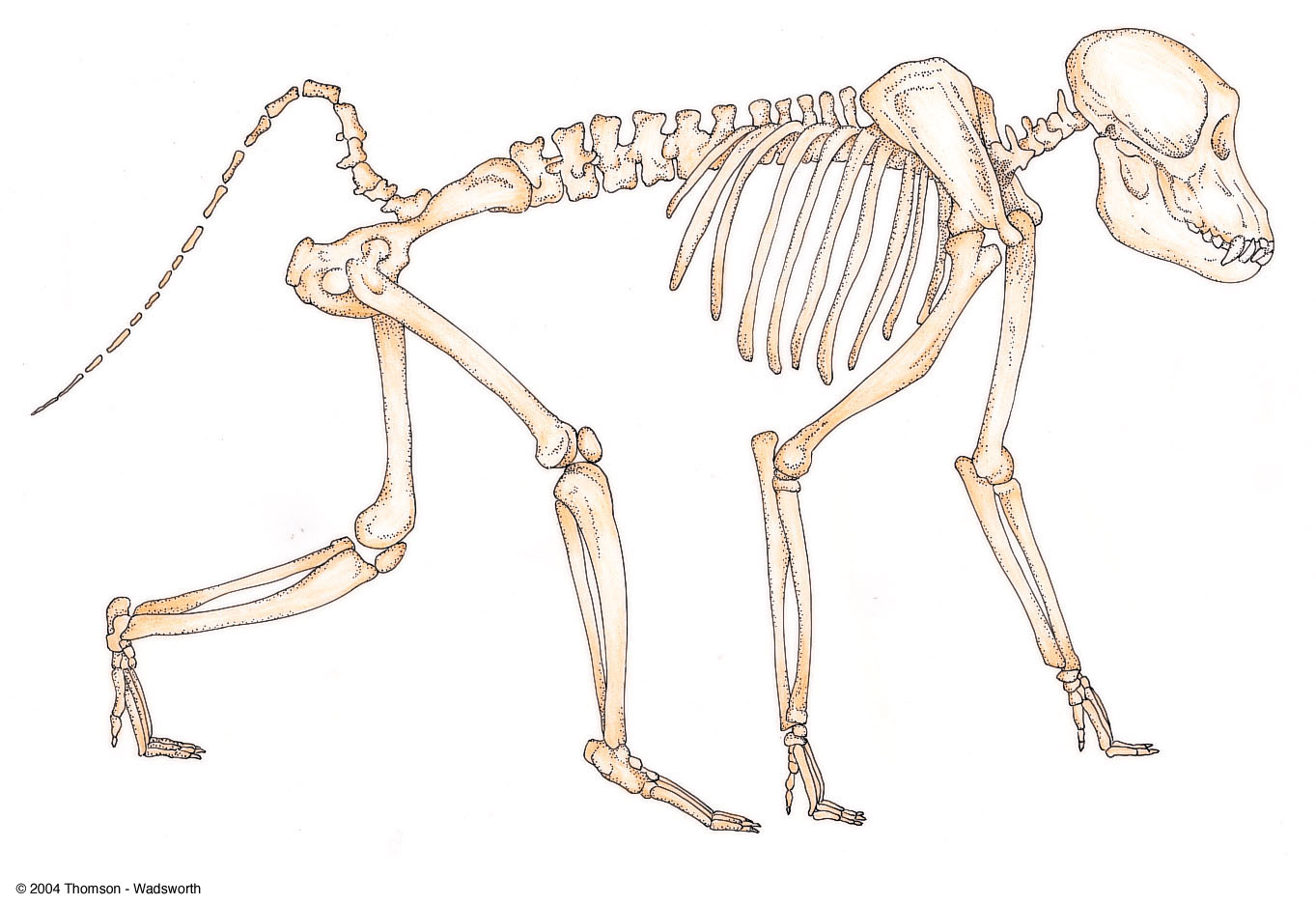
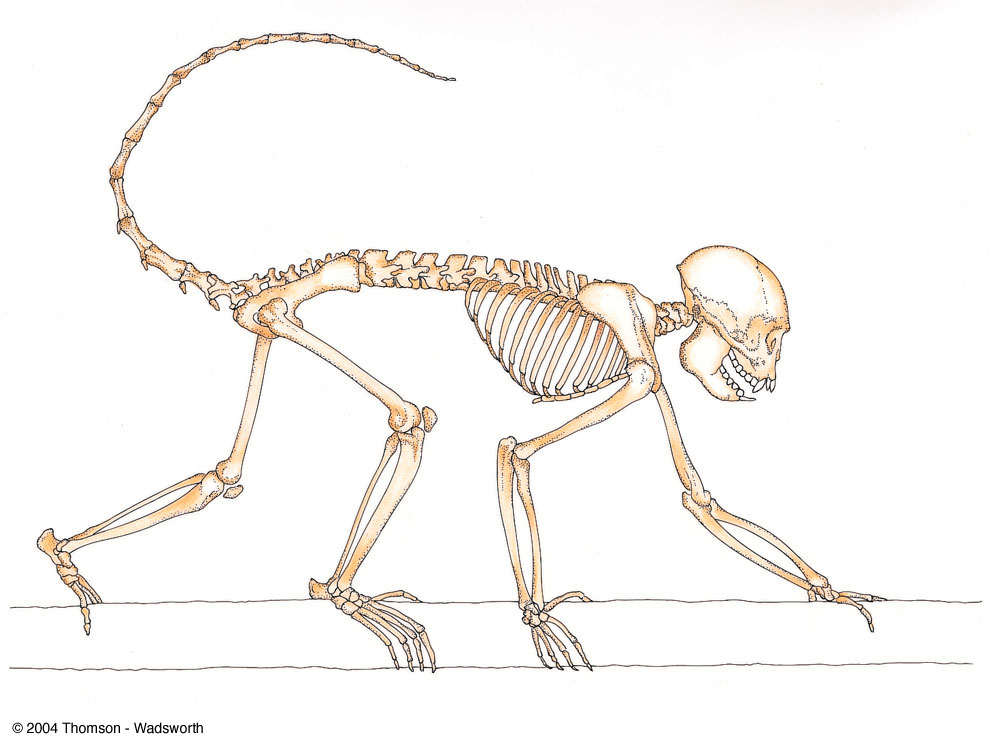
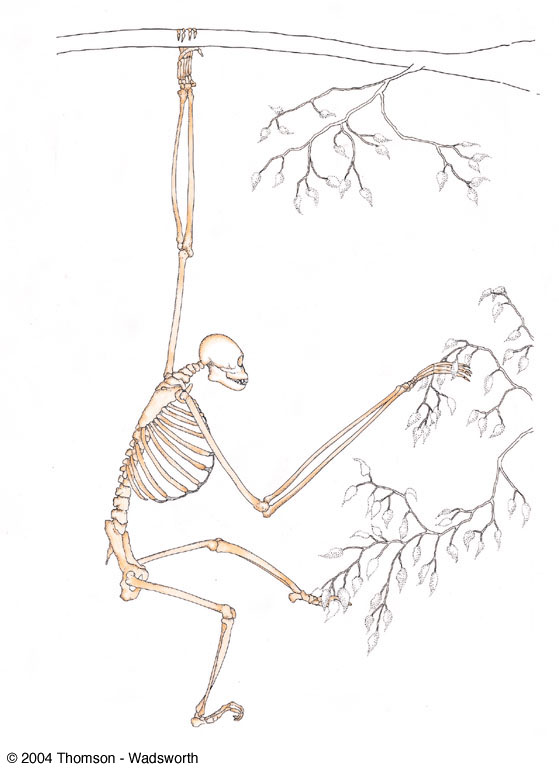
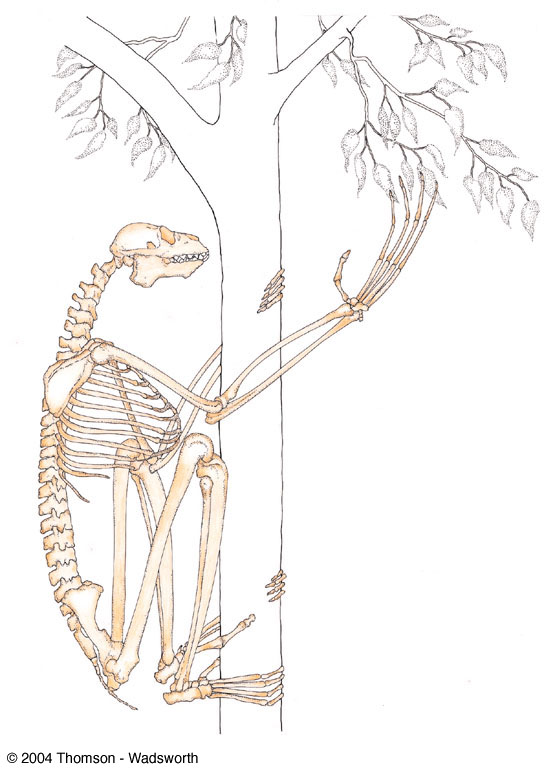
More detail on the locomotor pattern and its connection to habitat and behaviour:
Terrestrial quadrupeds
Front and hind limbs almost even length (forelimbs 90% of hind limb length), fast runners. Food/environment: tend to live in savanna or open areas, sit on the ground to eat seeds etc. Often tend to sleep in trees or on cliffs to avoid predators. Usually live in large groups. Tail not prehensile.

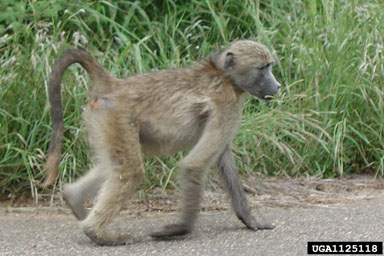
Savanna baboon
Papio cynocephalus
Arboreal - tend to walk on top of branches more than swinging below them (think squirrels). Forelimbs 70-80% length of hind limbs. (Need more power in the back for jumping than in the front.) If in the New World, often have prehensile tails. In the Old World, often have long tails which are used for counterbalancing, but are not prehensile. Hands and feet are good for grasping.

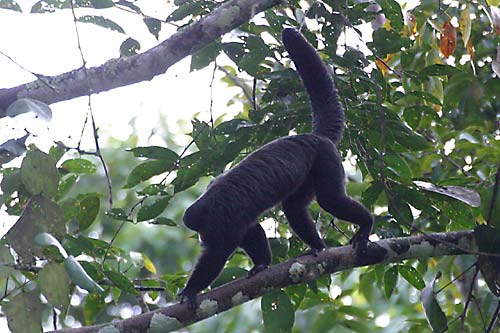
White-nosed Bearded Saki (Chiroptes albinasus)
Prehensile Tail: interestingly, also seen in other orders of arboreal animals, like lizards, porcupines, opossums...
Spider monkey, right -->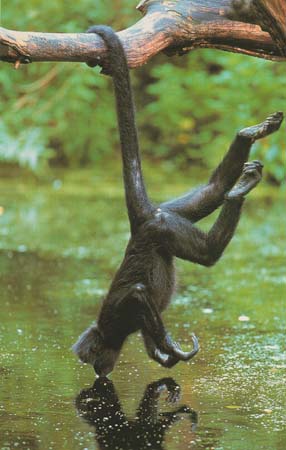
http://primates.com/monkeys/spidermonkey.html
Vertical clingers/leapers
Most often seen in prosimians (lemurs, tarsiers) - clinging to tree trunks. Hands very good for grasping. Live in forest: some eat bugs, tree sap, invertebrates, while others species eat leaves, fruit etc. Tend to live in small colonies, pairs, or to be mostly solitary.


INDRI (Indri indri)
Tarsier: another vertical clinger/leaper. Note pads on hands and huge (immobile!) eyes.
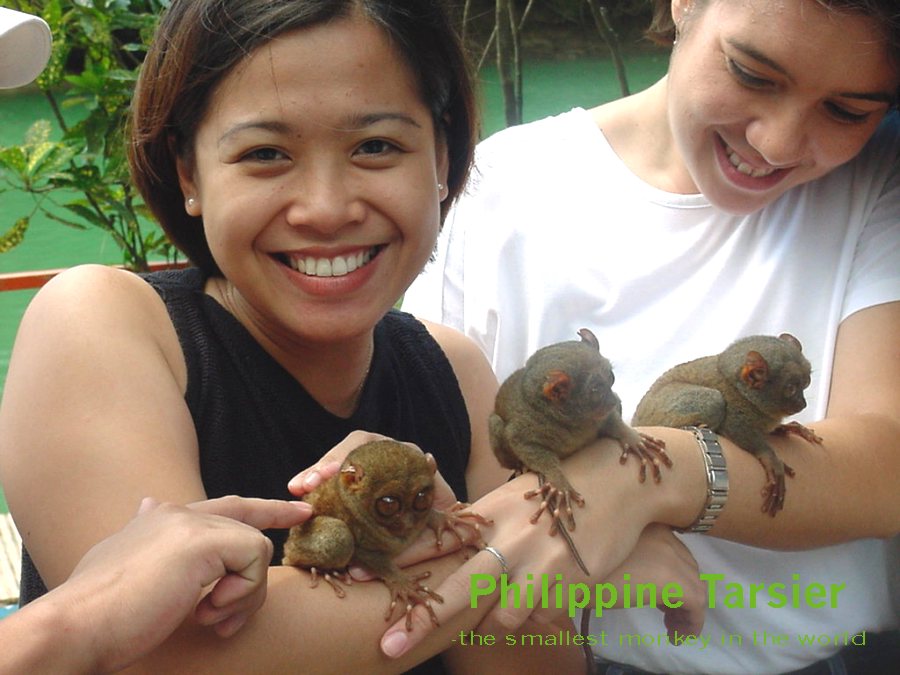
http://primates.com/philippine-tarsier.html (n.b. not actually smallest 'monkey' ... that's the pygmy marmoset, over in the New World)
Brachiators/ arm swingers: apes, including lesser apes (gibbons and siamangs), great apes (chimps, bonobos, gorillas, orangs). Generally longer arms than legs. Can support entire body hanging from one arm. Live in forest: tend to hang from branches and eat fruit.
Gibbons: live in pairs or very small family groups.
(Humans too... our legs are long by comparison, but we still have the suspensory shoulder adaptation.)

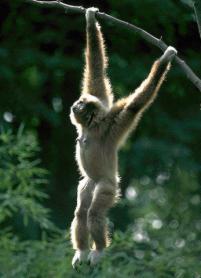
Gibbon (Hylobates sp)
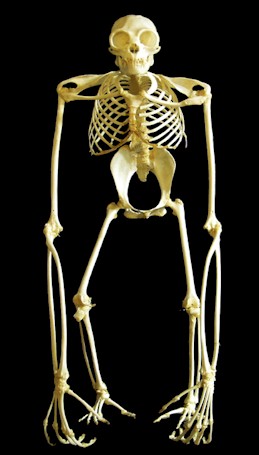
N.b. other locomotor variants
Orangs - quadrumanous - i.e. feet and hands all have opposable thumbs! primarily arboreal, use feet just like hands, unbelievably flexible. Eat fruit, tend to live alone or in very small groups.
Gorillas and chimps - knuckle-walkers but also climb trees. Gorillas live in small extended family groups and primarily eat leaves/stems, chimps in somewhat larger groups and primarily eat fruit.
Bipedalism - mostly just us and our ancestors -- the point at which habitual bipedalism emerged is much-discussed -- but bipedalism does occur occasionally in many primates. e.g. the sifaka bounces along bipedally, injured chimps may walk bipedally, and occasionally a monkey will develop the habit too.
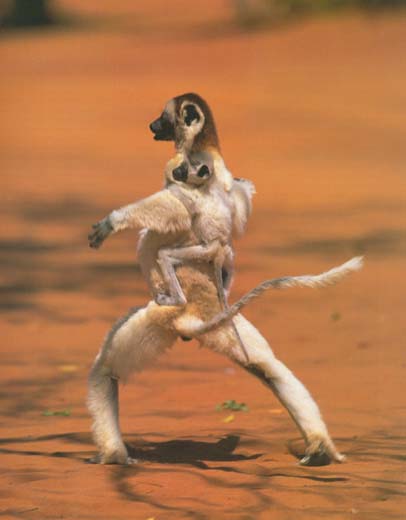
Sifaka travelling bipedally http://primates.com/lemurs/sifbab.html
Another e.g. Natasha the bipedal monkey (unusual): http://www.primates.com/monkeys/bipedal.html
Finetuned adaptations in primates: Example, Aye-aye finger
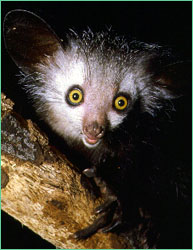
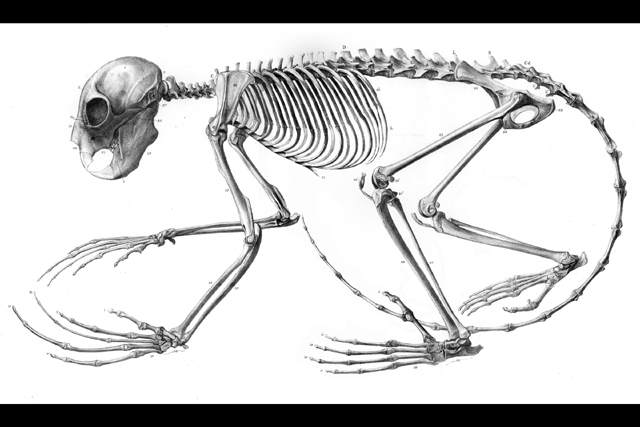
n.b. Extant primate skeletons and knowledge of primate behaviour helps us to understand the behaviour of fossil primates, including hominids. e.g. knees, feet, big toe, forearms, neck position, pelvis
Primate Behavior
Primates exist in a tremendous range of shapes and sizes, from the pygmy marmoset to the gorilla. They also have a host of different behaviour patterns:
-some live in large groups, others in small groups, pairs, or mostly alone
-eat anything from bugs to fruit to other animals
- in some species, males and females look the same, and in others they differ
- live anywhere from snow to tropics
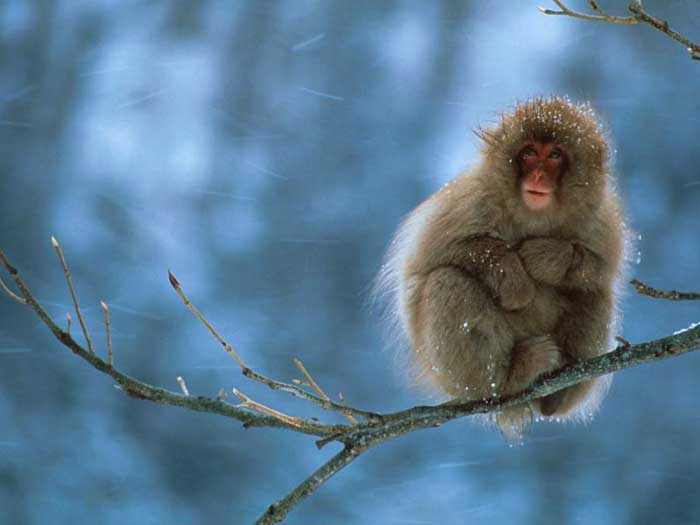
e.g. Japanese Macaque
http://primates.com/snowmonkeys/snowmonkey.html
e.g. Pygmy Marmoset: http://www.rarespecies.org/pygmy2.htm
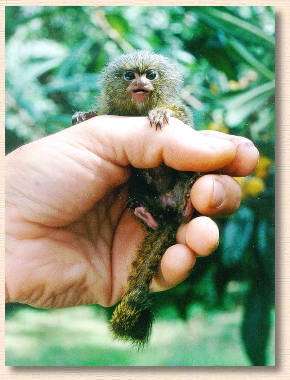
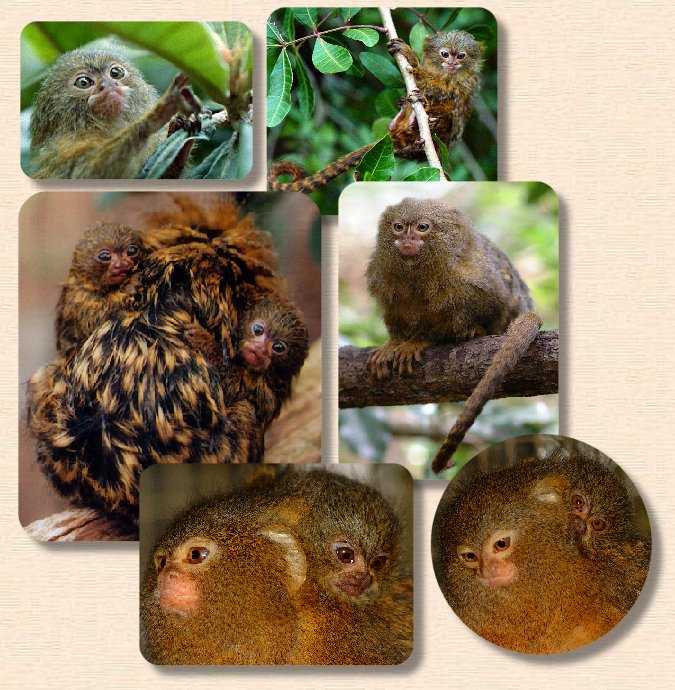
Pygmy Marmosets.
Note the twins -- normal for callitrichids (marmosets and tamarins)
--
cared for by both parents, father carries them
http://www.rarespecies.org/pygmy.htm
Photo gallery showing diversity of primates
http://primates.com/
Communication
Raised body hair is an example of an autonomic response.
Vocalizations and branch shaking are examples of deliberate communication.
Reassurance is communicated through hugging or holding hands.
The fear grin, seen in all primates, indicates fear and submission.
Displays communicate emotional states.
Many primate expressions are familiar to us, but n.b. their function has shifted a bit in humans. e.g. the fear grin and our smile can be similar.
N.b. Staring is very bad behaviour among primates.

Aggression
Primates might defend a core area within their permanent home.
Jane Goodall witnessed unprovoked, brutal attacks of chimpanzees by other chimpanzees.... apparently territorial at least some of the time
Territoriality and acquisition of females are the motives suggested for chimpanzee male aggression.
Affiliative Behaviors
Reinforce bonds between individuals and enhance group stability:
Grooming reinforces social bonds.
Hugging, kissing and grooming are all forms used in reconciliation.
Relationships are crucial to nonhuman primates and the bonds between individuals can last a lifetime.
Altruism, behaviors that benefit another while posing risk to oneself, are common in primate species.
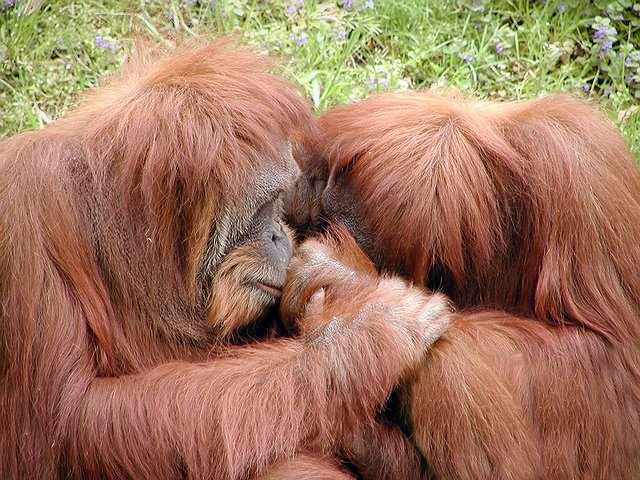
http://primates.com/orangutans/oran.html
Patterns of Reproduction
In most primate societies, sexual behavior is tied to the female’s reproductive cycle. Females are not always receptive -- and males are not always interested. Each female has a little flurry of mating activity for a while each cycle, apparently corresponding with ovulation. Many have visual cues, e.g. swelling or colouring of genitalia or even secondary tissue.
http://www.sciencebuff.org/orangutan_estrus_cycle_details.phpMale and female Bonobos may mate even when the female is not in estrus, a behavior that is not typical of chimpanzees or other primates. (Also more same-sex activity in this species)
Non-human primates have a range of mating patterns, ranging from permanent pairs (gibbons and callitrichids) to `favourite` partners, to more widespread mating.
Permanent bonding is not common among nonhuman primates.... but it does exist. So do `consortships`.
Reproductive Strategies
Primates produce only a few young in whom they invest a tremendous amount of parental care. (k –selected rather than r-selected)
The young are very dependent upon their mothers and the group.
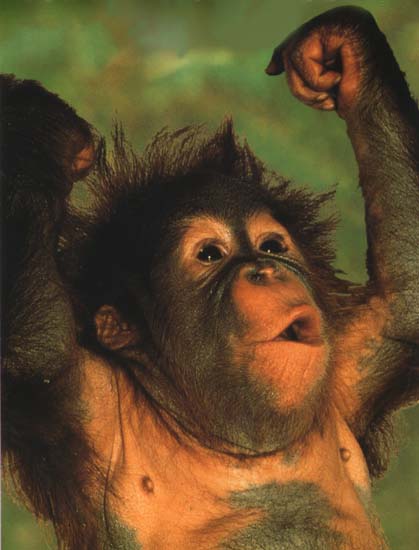
http://primates.com/orangutans/baby.htm
And young primates (like many young mammals) play a lot

http://primates.com/snowmonkeys/snowball.html
Mothers and Infants
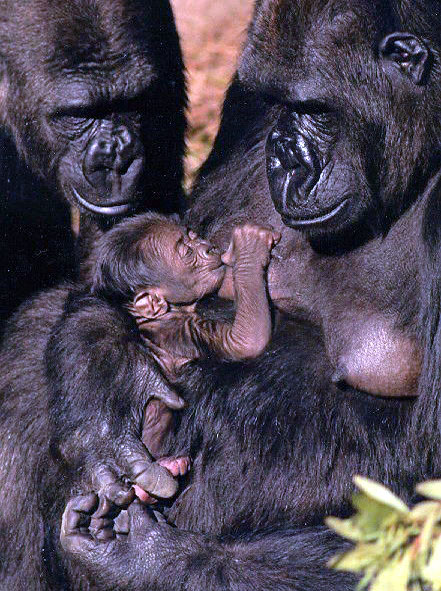
http://www.hedweb.com/gorilfam.htm
The basic social unit among all primates is the female and her infants.
Monkeys raised without a mother were not able to form lasting affectional ties - Harlow.
The mother-infant relationship is often maintained throughout life.
The role of the male varies according to species: some (e.g. callitrichids) are very active parents, whereas others play no particular role.
Others in the social group may also engage in parenting behaviour, e.g. older siblings, other relatives.
Nonhuman Primate
Cultural Behavior
Cultural behavior is learned and passed from one generation to the next.
Chimpanzee culture includes tools such as termite fishing sticks and leaf sponges.

http://primates.com/chimps/chimpwat.htm
Chimpanzee tool use:
http://news.nationalgeographic.com/news/2004/10/1006_041006_chimps.html
The Primate Continuum
Human brains are larger than primate brains, but the neurological processes are functionally the same.
Nonhuman primates think and have feelings. We may not understand them, but that does not disprove their presence.
An astonishing blindness: That humans are part of an evolutionary continuum is the basis for animal research, yet we cage nonhuman primates with little regard for their needs.
Captive primates should be maintained in social groups and have access to habitat enrichment programs.
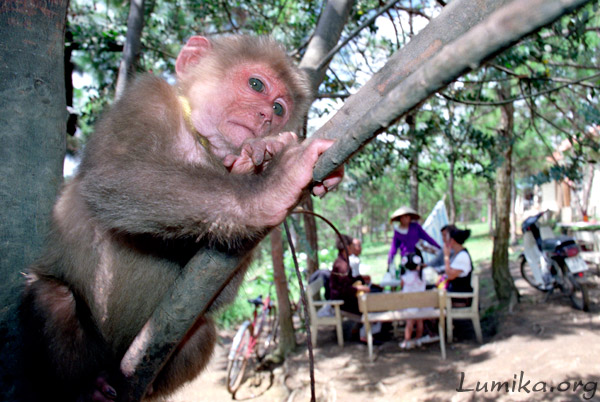
photo by Tommy Hayne. Captive monkey in Vietnam, 1994
What can non-human primates tell us about human beings?
Being careful about our inferences
"Back in the late 1920s, the anatomist Solly Zuckerman reported strong dominance hierarchies and high levels of 'aggression' and fighting among the large but confined hamadryas baboon colony at London Zoo, and developed an influential theory of social behavior based on these studies...Later researchers, observing baboon colonies in much larger enclosures or in the wild, failed to find similar levels of fighting. Instead, the groups seemed relatively peaceful and stable.
"It became obvious--and, with hindsight, it seems scarcely surprising--that the behavior of Zuckerman's baboon group had been dramatically modified by restricting the space within which its members had to coexist. The constraints of [the baboon group's space] had transformed the situation he wished to study and fundamentally misled him..."
(Rose, Steven; *Lifelines: Biology Beyond Determinism*; Oxford University Press, Oxford; 1998; pp. 28-29)
Why is this important?
Because of the conclusions about HUMANS that are drawn on the basis of primate studies.
This happens even at the highest levels of government. e.g. Francis Fukuyama, a political theorist who has been an advisor to the White House, uses chimpanzee behaviour to argue that aggressive, masculine-style politics are necessary on the international political scene.
Whether you believe his conclusions or not, it is inappropriate to use non-human primate behaviour to justify or determine our own human choices. What if, instead of looking at specific episodes of violence among chimpanzees, he had focused upon peace-making behaviour among bonobos (who are more closely related to us anyway)? What would his conclusions have been then? Primate behaviour is extremely diverse -- so by choosing a different species, you can make any argument you like about human behaviour. It might be rhetorically effective, but that doesn't mean it's logical.
(An answer to Fukuyama: http://www.foreignaffairs.org/19990101faresponse956/barbara-ehrenreich-katha-pollitt/fukuyama-s-follies-so-what-if-women-ruled-the-world.html )
Here's a nice article from primate researcher Frans DeWaal about our primate heritage: http://www.timesonline.co.uk/article/0,,2092-1848865,00.html
Like many higher-order vertebrates, primates have both innate and learned behaviour. Behavioural plasticity (capacity to change) is a key primate adaptation.
Theoretical systems for studying and explaining behaviour:
socioecology - examines relationships between components of the environment and behaviour (i.e. we would expect to see behaviours
sociobiology - looks at the relationship of natural selection and behaviour (i.e. we would expect to see behaviours that would maximize an individual`s success in spreading their genes and rearing their relatives to reproductive age) - the case of infanticide among langurs
n.b. no one system can explain everything!
To understand behaviour in a species, including social structure, you need to understand:
* diet (including quantity, quality, caloric value of foods)
* spatial distribution of foods (lots everywhere, scattered, clumped...)
* distribution and reliability of water sources
* body size, basal metabolic rate (energy requirements)
* distribution and types of predators
* distribution of sleeping sites
* activity patterns - nocturnal, diurnal, crepuscular
* relationships with other (nonpredator) species, including primate and nonprimate
* impact of human activities (if primates are being observed, they are being impacted!)
Many variations are correlated to body size. E.g. male and female primates that live in pairs tend to be nearly the same size (gibbons), whereas in species that live in groups, there is more sexual dimorphism (gorillas, baboons)
Socioecology and Predation
Environmental factors influence on group size and structure.
Multimale and multifemale groups have an advantage when predation pressure is high.
Adult males may join forces to attack predators.
Savannah baboons have been known to kill domestic dogs and attack leopards and lions.
Solitary foraging may be due to diet and distribution of resources or predator avoidance.
Evolutionary Perspective
Natural selection acts on behavior just as it acts on physical characteristics.
Behavior is a phenotypic expression and genes code for specific behaviors.
Natural selection has a role in shaping primate behavior.
Criticism of the Evolutionary Perspective
Little data on:
The social behavior of large groups of animals.
Genetic relatedness through the male line.
Assigning reproductive costs and benefits to particular behaviors.
The genetics of primate social behavior.
Dominance Status
Dominance has historically been a major focus for primatologists, but reanalyses have shown that it can be a bit overrated. (Perhaps early British primatologists studying baboons in captivity saw a mirror of British society... Zuckerman vs. Strum)
Broadly speaking, factors that influence status:
Sex
Age
Aggression
Time in the group
Intelligence and resourcefulness
Motivation
Mother’s social position
Primate Cognitive Abilities
Social interactions and problem-solving abilities demonstrate primate intelligence.
The fact that apes can’t speak has more to do with their anatomy and the language related structures of the brain than intelligence.
They do have communication systems, and our understanding of these is constantly developing.
Primate Sounds:
http://www.monkeymania.co.uk/gosounds/Koko the gorilla:
http://www.gorilla.org/world/daily.Koko meets Mr. Rogers:
http://ali.apple.com/ali_sites/ali/exhibits/1000790/koko_meets_the_stars.htmlhttp://www.pbs.org/teachersource/scienceline/archives/aug99/aug99.shtm
Bottom line: non-human primate studies can contribute to our understanding of human beings, but one should be very careful about the assumptions regarding non-human primates, and even more careful about how the information is used. Simple arguments are usually flawed.
ON THE FUTURE OF OUR CLOSEST RELATIVES:
The situation is very severe.
http://news.nationalgeographic.com/news/2004/09/0930_040930_bushmeat1.html,
Great Apes Survival Project:
http://www.unep.org/grasp/Bushmeat:
http://bushmeat.net/about.html , http://karlammann.com/
Some recent primate research follows.
ANDi, the GM Monkey
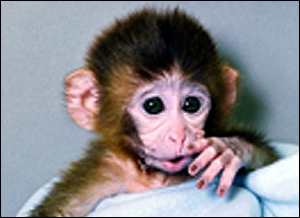
http://news.bbc.co.uk/1/hi/sci/tech/1112171.stm
If you're interested...
Fossil Primates - always an adventure!
Illustration by Kim Reed-Deemer, Northern Illinois University
Reconstruction of a 45 million year old primate, the size of a human thumb! The smallest primate ever discovered.
See below for full story.

From left to right the primate species depicted
on the tree are: a lemur
(Lemur catta), an adapid (Hoanghonius stehlini), a tarsier (Tarsius
bancanus), an omomyid (Shoshonius cooperi), a proto-monkey (Eosimias
centennicus), a South American monkey (Saimiri sciureus), an Old
World
monkey (Mandrillus sphinx), a great ape (Gorilla gorilla), and a
human
(Homo sapiens). Inset: new fossil, Eosimias. Full story, below.
Researchers discover fossils
of tiny, thumb-length primates
 DEKALB,
Ill.—A team of researchers led by Northern Illinois University paleontologist
Dan Gebo has discovered the fossils of 45 million-year-old, thumb-length
primates.
DEKALB,
Ill.—A team of researchers led by Northern Illinois University paleontologist
Dan Gebo has discovered the fossils of 45 million-year-old, thumb-length
primates.
http://www.niu.edu/pubaffairs/RELEASES/2000/MAR/primate/Tinyprimates.htm
For more primate information
Primate Info Net http://pin.primate.wisc.edu/
Bush meat / conservation crisis: http://news.nationalgeographic.com/news/2004/09/0930_040930_bushmeat1.html
New methods of studying primates in the field: e.g. radio telemetry to study ayeayes: http://www.pbs.org/wgbh/nova/kalahari/ayeaye.html
What's in that other 2%? http://www.medicalnewstoday.com/medicalnews.php?newsid=12739
More on Pygmy Marmosets
http://www.pbs.org/wnet/nature/gremlins/index.html
http://www.zoo.org/educate/fact_sheets/marmoset/marmoset.htm
http://facultad.usfq.edu.ec/renatol/files/galeria%20foto2.htm
Some skeleton images: http://www.hitchams.suffolk.sch.uk/skeletons/monkey.htm
Chimps
http://www.janegoodall.org/chimp_central/default.
Primate self-medication: http://primates.com/misc/index.html
Gibbon playing with Tiger: http://www.warthai.org/gallery%20pages/gibtiger.htm,
http://media.hugi.is/hahradi/fyndnar/apetiger.wmv